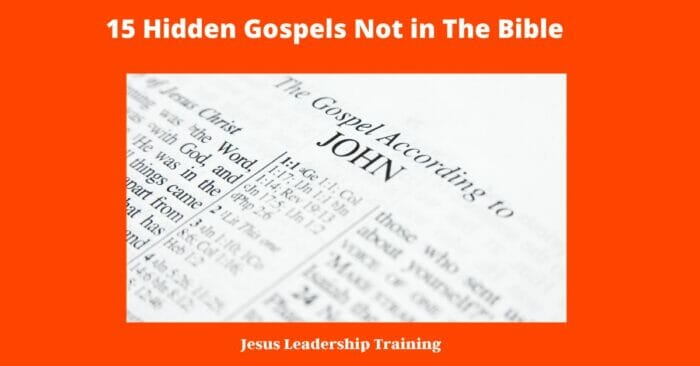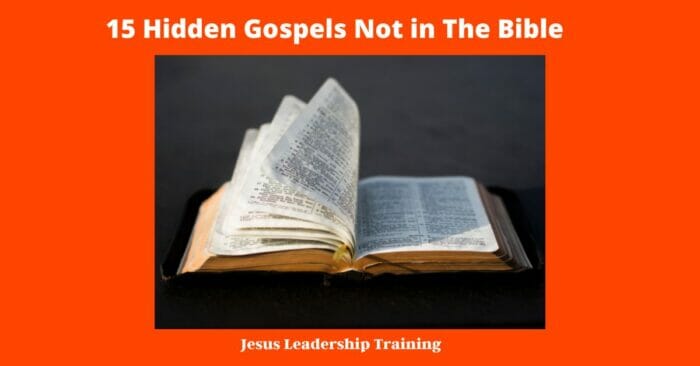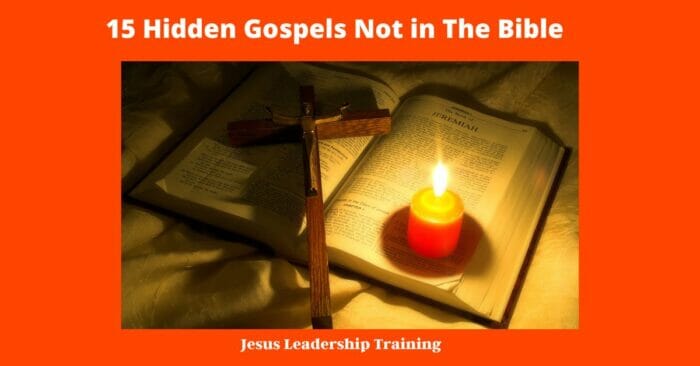There are many Gospels that were not included in the Bible. These Gospels offer different perspectives on the life of Jesus Christ and his teachings. Some of these Gospels are more controversial than others, but they all offer valuable insights into the character and mission of Jesus. In this blog post, we will explore eleven Gospels that were not included in the Bible and discuss what they teach about Jesus Christ.
Table of Contents
15 Hidden Gospels Not in The Bible
- Gospel of Judas
- Gospel of Macron
- Secret Gospel of Mark
- Gospel of Barnabas
- Gospel of Peter
- Gospel of Phillip
- Gospel according to the Hebrews
- Gospel of the Nazarenes
- Gospel of Thomas
- Gospel of the Savior
- Epistle of the Apostles
- Gospel of the Egyptians
- Gospel of Nicodemus
- Gospel of Ebionites
- Gospel of Truth
Why are the Apocryphal ( Apocryphal writings) Gospels Not in The Bible?
There are a number of reasons why the Apocryphal Gospels are not included in the Bible. The first reason is that they were written too late to be considered inspired by God. The earliest of these texts were written in the second or third century, long after the events they purport to describe took place. Not in the First Century when most of the New Testament Transpired.

In addition, many of these texts were not widely circulated until after the Council of Nicea in 325 AD. As a result, there was simply no way for them to be included in the Bible. Another reason for their exclusion is that they contain a number of historical and theological errors.
For instance, the Gnostic Gospel of Thomas claims that Jesus was born in Alexandria, Egypt, which is clearly false. Similarly, the Gospel of Peter describes Jesus as being crucified upside down, which is also not supported by any other sources. Ultimately, these texts had good reasons to be also called the lost gospels and are not included in the christian Bible. simply don’t meet the criteria for inclusion in the Bible. They are described as noncanonical text.
What are the Canonical Gospels (New Testament Gospels)
When most people think of the Gospels, they think of the New Testament Gospels. However, there are actually four Gospels in the Bible: Matthew, Mark, Luke, and John. These four Gospels are often referred to as the Canonical Gospels because they were included in the canon of the New Testament.
The Canonical Gospels were written by four different authors, each with their own unique perspective. However, all four Gospels tell the story of Jesus Christ and his teachings. The Canonical Gospels are essential to our understanding of the life and work of Jesus Christ.
They provide us with an eyewitness account of his ministry, his miracles, and his death and resurrection. Without the Canonical Gospels, our understanding of Jesus Christ would be greatly diminished.
The word “gospel” comes from the Old English word “godspel”, which means “good news”. In the New Testament, the term “gospel” refers to the four books that tell the story of Jesus Christ: Matthew, Mark, Luke, and John. These books are sometimes referred to as the “Synoptic Gospels” because they share a similar narrative style.
The Gospel of John, however, is significantly different from the other three gospels in both content and tone. While the Synoptic Gospels focus on Jesus’ public ministry, John emphasizes his private relationships and conversations. As a result, each gospel provides a unique perspective on the life and teachings of Jesus Christ.
What are the Apocryphal Gospels?
The word “apocryphal” comes from a Greek word meaning “hidden.” The Apocryphal Gospels are a collection of early Christian texts that were not included in the Bible. While they are not considered to be part of the canon, they can provide valuable insights into the beliefs and practices of early Christians.
The most famous of the Apocryphal Gospels is the Gospel of Thomas, which contains sayings attributed to Jesus that are not found in the Bible. Other well-known texts include the Gospel of Mary, the Gospel of Judas, and the Secret Gospel of Mark.

These texts often differ from the canonical Gospels in their portrayal of Jesus and his teachings. For example, the Secret Gospel of Mark includes an account of a sexual encounter between Jesus and a young man.
While the Apocryphal Gospels are not considered to be scripture, they can still be studied for their historical and theological significance. For many Christians, they provide a window into the diverse beliefs and practices of early Christianity
Why Were these Extra Gospels written and ascribed to various Authors?
Gospels Not in The Bible
There are a number of reasons why these extra Gospels were written and ascribed to various authors. First, the early Christians were struggling to define what it meant to be a follower of Christ. This was a time of great religious and political turmoil, and there were many competing ideas about who Jesus was and what his teachings meant.
As a result, some people wrote Gospels that emphasized certain aspects of Jesus’ life and teachings in order to promote their own ideas about his identity. For example, the Gospel of Thomas emphasizes Jesus’ sayings, while the Gospel of Mary concentrates on his miraculous deeds. In addition, some people wrote Gospels in order to attack the teachings of their opponents.
The Gnostic Gospels, which were written by a group of subversives called the Gnostics, claimed that Jesus was not really human but was instead a divine being who came to enlighten humans about the true nature of reality.
Finally, it is also possible that some people wrote the Gospels simply because they wanted to share their own personal experiences with Jesus. Whatever their motives may have been, these extra Gospels provide us with a valuable window into the religious beliefs and practices of early Christianity.
Gospel of Judas
The Gospel of Judas was written sometime between the years 150 and 330. It is a Gnostic gospel, meaning that it promotes the belief that secret knowledge (gnosis) is required for salvation. The book tells the story of Jesus from the perspective of Judas Iscariot, one of his twelve disciples.
Judas is portrayed as a faithful follower who has been misunderstood by history. In reality, it was Judas who truly understood Jesus and his message. At the end of the gospel, Judas betrayals Jesus at Jesus’ request in order to help him complete his mission.

The Gospel of Judas has been controversial since it was first discovered in the 1970s. Some scholars believe that it is an authentic ancient text, while others believe that it is a forgery. There is no way to know for sure who wrote the Gospel of Judas or when it was written, but its existence provides insight into some of the different beliefs about Jesus during the early centuries of Christianity.
Gospel of Macron
The Gospel of Macron was an apocryphal gospel that was written in the early 3rd century. It is a Gnostic gospel that attempts to provide a different perspective on the life of Jesus Christ. The gospel was probably written in Alexandria, Egypt. It is thought to have been written by a Gnostic teacher named Basilides.
The Gospel of Macron features a unique cosmology and includes some Gnostic elements. However, it does not contain the full Gnostic teachings. The gospel also includes some sayings of Jesus that are not found in other gospels. Overall, the Gospel of Macron provides an interesting alternative view of the life of Jesus Christ.
Secret Gospel of Mark
The Secret Gospel of Mark is an apocryphal gospel that was likely written in the 2nd century. It consists of an additional story about the disciple Mark, who goes to live with Jesus in secret.
The text of the Secret Gospel is only found in a letter that was written by Clement of Alexandria in the early 3rd century. In this letter, Clement quotes from a secret edition of the Gospel of Mark that he had seen.
The quoted portion includes a story in which Jesus raises a young man from the dead and then teaches him privately for several days. Some scholars believe that the Secret Gospel of Mark was created to provide additional evidence for the belief that Jesus was divine. Others believe that it was written in order to provide additional support for the practice of private baptism. However, the true purpose of the Secret Gospel of Mark remains a matter of debate.
Gospel of Barnabas
The apocryphal Gospel of Barnabas was probably written in the late fourth or early fifth century AD. It purports to be the autobiography of Barnabas, one of the twelve apostles of Jesus Christ. The work is highly legendary and contains many miraculous stories about Barnabas that are not found in the canonical Gospels.
For example, it claims that Barnabas was the true author of the Gospel of Matthew and that he witnessed Jesus ascending into heaven in bodily form. The book also includes a number of Islamic doctrines, such as the teaching that Jesus was not crucified but rather it was Judas Iscariot who was put to death in his place. While the Gospel of Barnabas is not included in the Bible, it is nonetheless an important work for understanding early Christian and Islamic beliefs.

Gospel of Peter
The Gospel of Peter is an apocryphal gospel dating back to the 2nd century. The gospel’s unknown author purports it to be a narrative of the events surrounding the crucifixion and resurrection of Jesus Christ, as told by the apostle Peter.
However, the text bears little resemblance to the canonical gospels, and its authenticity has been hotly contested by scholars. Some believe that the author wrote it in order to provide a more sympathetic account of Peter’s role in the events leading up to and following Jesus’ crucifixion. Others believe that it was written as a response to Gnostic Christianity, which was gaining popularity in the 2nd century.
Whatever the case may be, the Gospel of Peter remains an important historical document, shedding light on early Christian beliefs and practices.
For example, it claims that Jesus was born from a virgin mother and that he raised a man from the dead. It also contains a detailed account of Jesus’ crucifixion, which is different from the accounts in the canonical Gospels.
The Gospel of Peter was not popular in early Christianity, and it was rejected by the Church Fathers. However, it is still studied by scholars today as an example of early Christian literature.
Gospel of Phillip
The Gospel of Phillip was written by an unknown author, most likely in the late second or early third century. It is a Gnostic gospel, meaning that it offers a different perspective on the nature of Jesus Christ and his relationship to God the Father.
The book is divided into three main sections: the first section focuses on the life of Jesus, the second section tells the story of Phillip’s conversion to Christianity, and the third section offers Gnostic interpretations of various biblical passages. While the Gospel of Phillip is not included in the Bible, it provides an interesting glimpse into the beliefs of early Christians who were outside the mainstream.
The sayings are mostly focused on topics like love, marriage, and celibacy. Some scholars believe that the book was written by a Gnostic Christian, because it contains Gnostic ideas. For example, the book teaches that we must become like Christ in order to be saved, and that the path to salvation is through knowledge and self-denial.
However, we cannot know for sure who wrote the Gospel of Phillip or what their intentions were. What we can know for sure is that the book provides us with a glimpse into the early history of Christianity and the diverse beliefs that existed within the religion.

Gospel according to the Hebrews
The Gospel of the Hebrews is a New Testament apocryphal gospel. The gospel was probably written in Egypt in the 2nd century, and it is one of the earliest and most important non-canonical gospels. The Gospel of the Hebrews was used by some early Christians, including Clement of Alexandria and Origen, and it was quoted by Justin Martyr, but it is now lost. Only fragments of the gospel survive in other ancient texts.
The Gospel of the Hebrews was probably written in Greek, but it may have originally been composed in Aramaic or Hebrew. The gospel was probably based on the canonical Gospels of Matthew and Luke, but it also included unique material not found in other gospels. For example, the Gospel of the Hebrews included a unique version of the Lord’s Prayer, which differed significantly from the version found in Matthew 6:9-13.
The Gospel of the Hebrews was an important source for early Christian thought, and it sheds light on the development of Christianity in the 2nd century. For example, the gospel’s unique version of the Lord’s Prayer provides insight into how early Christians prayed. However, because the gospel is now lost, modern scholars must rely on secondary sources to reconstruct its contents.
Gospel of the Nazarenes
The apocryphal Gospel of the Nazarenes is a non-canonical gospel that was written sometime in the second century AD. The author is unknown, but it is thought to have been composed in Egypt or Syria. The gospel presents a different view of Jesus than what is found in the canonical Gospels, and it has been suggested that it may have been used as a source for the Gnostic Gospels.
The text of the Gospel of the Nazarenes has been partially preserved in a number of fragmentary manuscripts, but its full contents are currently unknown. Nevertheless, the available fragments provide an insight into an Early Christian text that was once widely circulated but is now largely forgotten.
Gospel of Thomas
The Gospel of Thomas is a collection of 114 sayings of Jesus. It is thought to have been written around the year 140, and it was discovered in 1945 near the Egyptian town of Nag Hammadi. The sayings are sometimes cryptic and they don’t tell a linear story, so they can be difficult to understand.
However, many scholars believe that the sayings provide profound insight into the teachings of Jesus. The sayings are organized into four sections, which each discuss different topics. The first section is about the kingdom of God, the second is about salvation, the third is about wisdom, and the fourth is about ethics.
Each saying is followed by a brief commentary that helps to explain its meaning. The Gospel of Thomas provides a valuable perspective on the life and teachings of Jesus, and it is essential reading for anyone who wants to deepen their understanding of Christianity.
Gospel of the Savior
The Apocryphal Gospel of the Savior is a Gnostic Christian text that was written sometime in the 2nd or 3rd century AD. The text contains various sayings and teachings of Jesus, as well as accounts of his miracles and Passion.
The Gospel of the Savior is believed to have been used by the Gnostics, who were a religious movement that arose in the 2nd century AD. The Gnostics believed that they possessed secret knowledge (gnosis) of God and the universe that was hidden from the majority of people.
They also believed that Jesus was not a physical being, but rather a spirit who appeared to humans in different forms. The Secret Gospel of the Savior offers a unique perspective on the life and teachings of Jesus, and provides insight into the beliefs of the Gnostic movement.

Epistle of the Apostles
The Epistle of the Apostles is a book that was written to summarize the teachings of Jesus Christ. The book was written by a group of early Christians who were living in Rome. The book was written in the late first or early second century.
The Epistle of the Apostles is a collection of twelve letters that were written by different authors. The book contains a lot of information about the early years of Christianity. The Epistle of the Apostles is an important book for anyone who wants to learn about early Christianity
Gospel of the Egyptians
The Gospel of the Egyptians is an apocryphal gospel that was written sometime in the 2nd or 3rd century AD. The author is unknown, but it is thought to have been written by someone associated with the Valentinian school of Gnosticism.
The gospel consists of sayings and teachings attributed to Jesus, some of which are found in other New Testament gospels, such as the Gospel of Thomas. However, the Gospel of the Egyptians also contains unique material, such as a dialogue between Jesus and Mary Magdalene in which Jesus reveals secret knowledge to her.
While the Gospel of the Egyptians was once widely circulated, it is now only known from a few fragmentary copies. Nevertheless, it remains an important early Christian text and provides valuable insights into the beliefs of early gnostic Christians.
Gospel of Nicodemus
The Gospel of Nicodemus also called the Acts of Pilate, is an apocryphal gospel that was written in the early 4th century. The gospel tells the story of the trial, crucifixion, and resurrection of Jesus Christ from the perspective of Pontius Pilate, the Roman governor who presided over the trial.
The author is unknown, but it is thought to have been written by a Christian who was sympathetic to Pilate. Despite its name, the gospel is not a true account of Pilate’s life; rather, it is a work of fiction that was meant to inspire hope and faith in its readers. Nonetheless, the Gospel of Nicodemus remains an important part of Christian tradition, and its message continues to resonate with people today.
Gospel of Ebionites
The Apocryphal Gospel of Ebionites is a gospel that was written sometime in the 2nd century. The precise date is unknown, but it was likely written between 140-180 AD. The author is also unknown, but the gospel was likely written by someone who was familiar with the teachings of the Ebionites, a Jewish Christian sect.
The Gospel of Ebionites offers a unique perspective on the life of Jesus and his teachings. It is one of the only sources that introduces the character of Barnabas, a close friend and follower of Jesus. The gospel also contains several sayings of Jesus that are not found in any other gospel.
For example, when asked about divorce, Jesus says “Whoever divorces his wife and marries another commits adultery.” This saying is significant because it shows that Jesus had a different view on divorce than what was later codified in Catholic doctrine.
The Gospel of Ebionites is an important historical document because it provides insight into the beliefs and practices of an early Christian sect. However, because it was not included in the Bible, it is not considered scripture by most Christians today.
Gospel of Truth
The Gospel of Truth was written by an unknown author, most likely in the 2nd century. It is a Gnostic gospel, meaning that it stresses the idea of secret knowledge that will lead to salvation. The book is only about 20 pages long and consists of a series of sayings attributed to Jesus.
Some of these sayings are similar to those found in the New Testament Gospels, but many are unique to this work. The overall message of the book is that through knowledge (gnosis) of God, humans can be liberated from their ignorance and find salvation.
While the Gospel of Truth is not included in the Bible, it is an important work for understanding the beliefs of early Gnostic Christians.
Final Thoughts – Gospels that are not included the Catholic Bible
Many of the Hidden Gospels were not included in the Cannon of the new testament because the Translators felt that they were more human works of literature instead of the Gospels that were inspired by the Holy Spirit.
What is important to remember is that these Gospels were all written within 100 years of Christ’s death, and they all contain unique perspectives on who Jesus was and what he taught. While some of these Gospels may not be considered scripture by most Christians today, they nonetheless offer valuable insights into the early history of Christianity.
God Bless Greg



